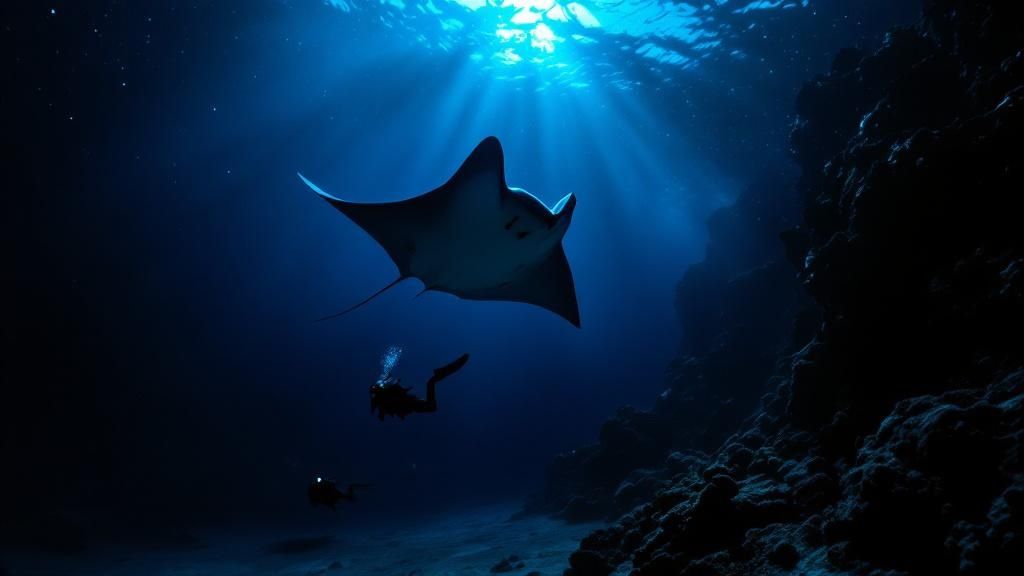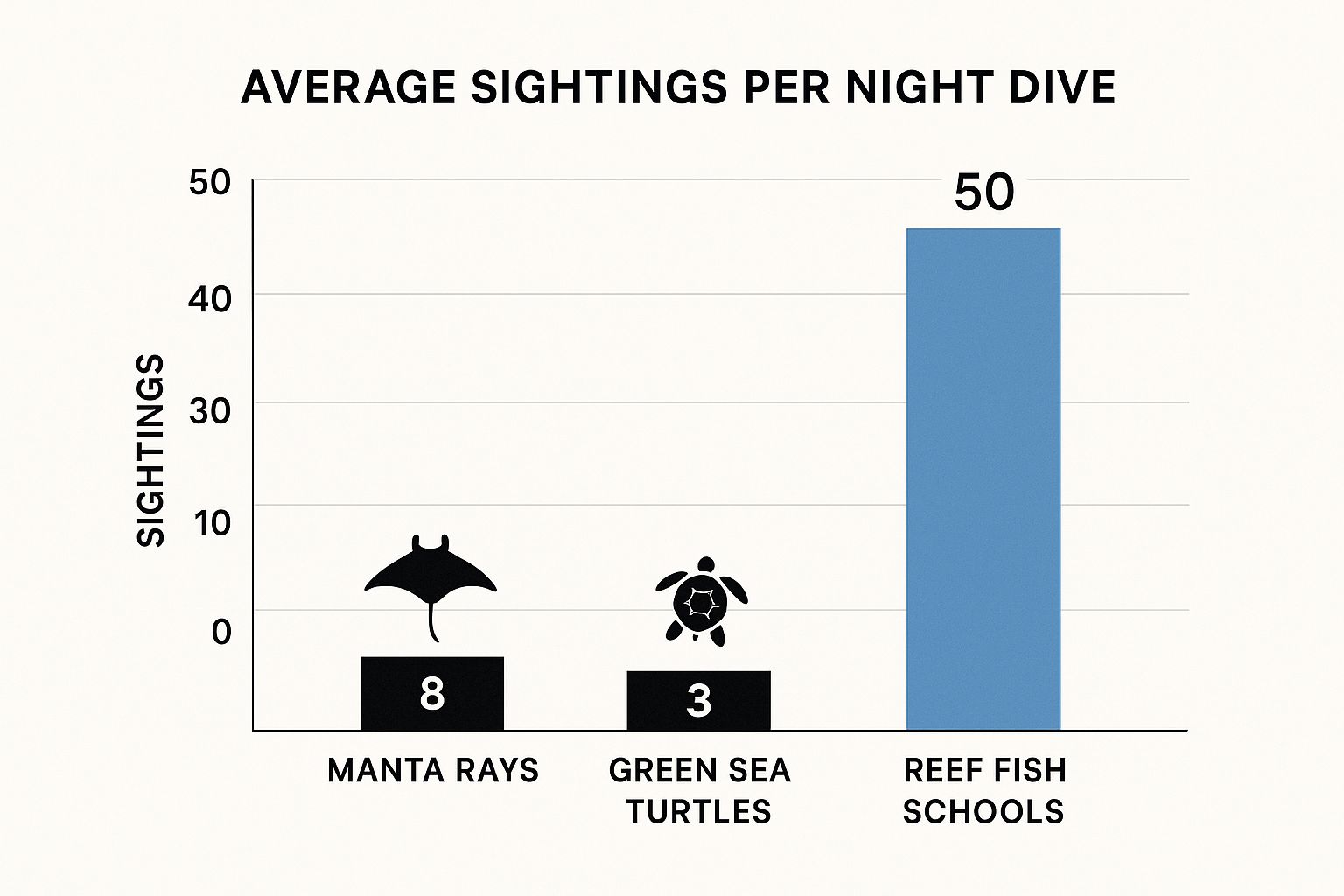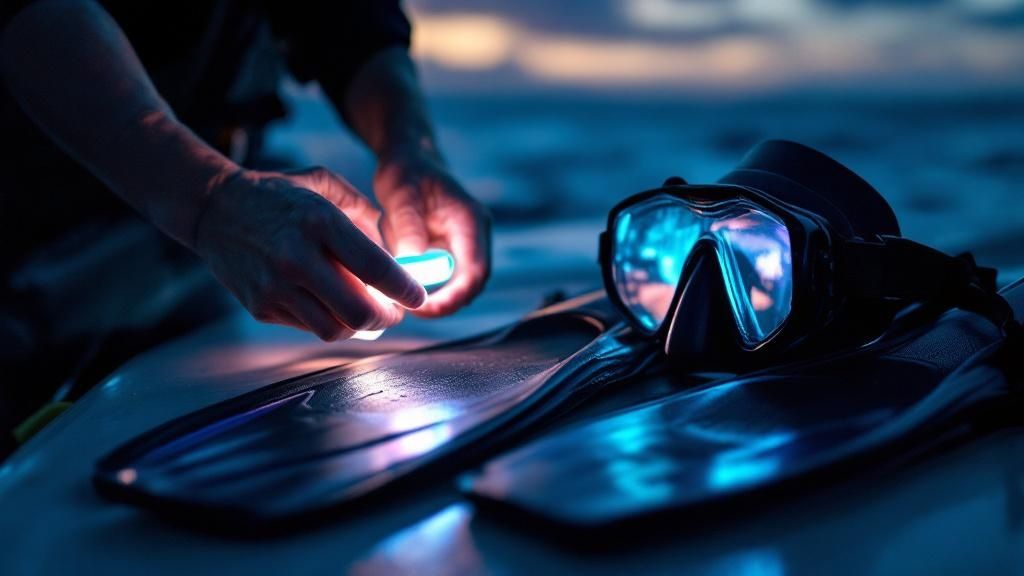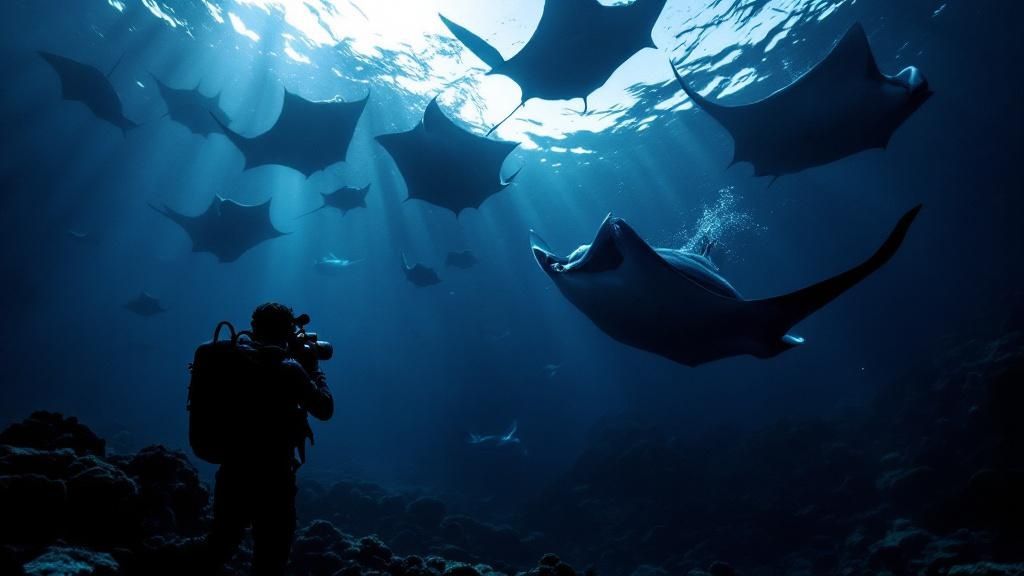Why Kona Delivers The World's Best Manta Ray Encounters
Kailua Kona is renowned as a premier diving destination, particularly for its unparalleled manta ray night dives. This isn't a coincidence. The area's unique volcanic topography and ocean currents create a perfect feeding ground for these gentle giants. Volcanic slopes plunge deep into the Pacific, causing upwelling, a process that brings nutrient-rich waters and microscopic plankton to the surface.
This abundance of plankton provides a feast for manta rays. Furthermore, the underwater landscape, shaped by ancient lava flows, creates natural bowls and channels. These features trap and concentrate the plankton in specific locations known as Manta Village and Manta Heaven. This predictability makes a manta ray encounter in Kona almost a guaranteed spectacle.
Kailua Kona boasts an impressive 80-90% success rate for manta ray sightings. This remarkable consistency stems from the reliable food source and favorable environmental conditions. The plentiful plankton provides a constant supply of nourishment, ensuring a thriving manta ray population. Find more detailed statistics here
The Geological Advantage of Kona
Kona's volcanic origins are key to its thriving manta ray habitat. The porous volcanic rock acts as a natural filter for rainwater, enriching it with minerals. This mineral-rich freshwater then seeps into the ocean, further enhancing plankton growth. This geological advantage sets Kona apart from other diving locations.
The combination of mineral-rich freshwater and upwelling creates a rich ecosystem that supports a large, healthy manta ray population. It’s a delicate balance that makes Kona a truly special place.
Consistent Environmental Conditions
Beyond geology, Kona's consistently warm, clear waters and gentle currents create an ideal environment for both manta rays and divers. This predictable environment has attracted marine scientists for years, fostering research and conservation efforts that deepen our understanding of these magnificent creatures.
The manta ray night dive in Kailua Kona is more than just an adventure; it’s a chance to connect with the natural world. It's a unique opportunity to witness these graceful creatures in their natural habitat. Check out our guide on manta ray night dives on the Big Island.
Kona: The Global Benchmark
Kona has set the global standard for manta ray tourism. The combination of established infrastructure, experienced operators, and high success rates makes it the premier destination for this unique experience. The area's consistent success and established tourism practices have also become a model for responsible and sustainable manta ray interactions worldwide. You might be interested in: How to master…

The manta ray night dive in Kailua Kona is an unforgettable experience, a direct result of the area’s remarkable natural environment. It's not just about observing wildlife; it's about experiencing the intricate interplay of geology, ocean currents, and marine biology that make Kona such a special place for these gentle giants.
Manta Village Vs Manta Heaven: Choosing Your Perfect Spot
Not all manta ray night dives in Kailua Kona are created equal. Choosing the right location can significantly enhance your underwater adventure. Let's compare Kona's two premier manta ray night dive destinations: Manta Village and Manta Heaven. This comparison will help you make an informed choice based on your diving experience and personal preferences.
Depth and Dive Conditions
Manta Village is known for its shallower depths, typically ranging from 3 to 10 meters. This makes it a great choice for beginners or divers who prefer a more relaxed experience. One of the key dive sites is, appropriately, called Manta Village. This shallower depth often translates to excellent visibility, providing stunning views as the mantas gracefully glide through the illuminated water. Learn more about Manta Village
Manta Heaven, on the other hand, sits at a depth of 10 to 12 meters. This slightly more challenging dive is generally better suited for experienced divers. This depth difference also influences visibility. While Manta Village regularly enjoys clear waters, visibility at Manta Heaven can sometimes be slightly reduced, particularly during plankton blooms—which, ironically, are what attract the manta rays.
Manta Ray Behavior and Encounters
Both sites offer amazing manta ray encounters, but the mantas' behavior can vary slightly between locations. At Manta Village, the shallower depth and proximity to the ocean floor create a more intimate experience, with mantas often swimming directly overhead. The smaller dive area can also lead to concentrated manta ray activity, even if the average number of mantas per dive might be slightly lower than at Manta Heaven.
Manta Heaven, however, often presents a spectacular display of numerous manta rays feeding together. Divers frequently witness groups of 10 to 15 mantas performing acrobatic barrel rolls and backflips as they feast on plankton. This creates a truly mesmerizing display, although viewed from a slightly greater distance due to the increased depth.
To help you better understand the differences between these two incredible dive locations, let's take a look at a detailed comparison:
Manta Village vs Manta Heaven Comparison
| Feature | Manta Village | Manta Heaven |
|---|---|---|
| Depth | 3-10 meters | 10-12 meters |
| Difficulty Level | Beginner-friendly | More Experienced Divers |
| Typical Manta Count | 5-10 | 10-15 |
| Best Conditions | Calm seas, clear water | Plankton blooms (can reduce visibility) |
| Manta Behavior | Close encounters, gliding overhead | Larger groups feeding, acrobatic displays |
As this table highlights, each site offers unique characteristics. Manta Village provides a more intimate experience in shallower waters, while Manta Heaven offers the chance to see larger groups of mantas engaged in dynamic feeding behaviors.
Crowd Management and Accessibility
Manta Village, being smaller and easily accessible, can sometimes become more crowded, especially during peak season. However, many dive operators stagger their dive times to minimize this. Manta Heaven, being a larger site, usually accommodates more divers without feeling as congested.
Choosing the Right Site for You
The following infographic provides a visual summary of some key differences in average sightings per night dive at these two locations:

As the infographic shows, while both spots offer incredible opportunities to see manta rays, Manta Village boasts a slightly higher concentration of reef fish. This makes it an appealing choice for those interested in a wider variety of marine life. Ultimately, the best choice for your manta ray night dive in Kailua Kona depends on your diving experience and priorities. Consider factors like depth comfort, visibility preferences, and the type of manta ray interaction you're hoping for. Both Manta Village and Manta Heaven offer unforgettable experiences, each with its own unique charm.
What Actually Happens During Your Manta Ray Night Dive
Your manta ray night dive in Kailua Kona is more than just a dive; it's a captivating experience orchestrated around light and marine life. Every detail, from gearing up to the final ascent, contributes to this magical encounter. Curious to learn more? What is a manta ray night dive?
The Descent into Darkness
As the sun sets, your dive boat adventure begins. Anticipation grows as you approach the dive site, either Manta Village or Manta Heaven. After a briefing covering safety procedures and manta ray etiquette, you enter the water as darkness envelops the ocean.
The Underwater Theater
Powerful lights strategically placed on the ocean floor create a mesmerizing underwater glow. These lights serve a crucial purpose beyond visibility – attracting plankton, the manta ray's main food source. The illuminated area transforms into an underwater stage, perfectly set for the main event.
The Manta Ray Ballet Begins
Drawn by the abundant plankton, the manta rays make their grand entrance. With wingspans reaching up to 20 feet, these gentle giants seem to fly through the water. They perform graceful loops and barrel rolls while feeding, their white underbellies illuminated by the dive lights. It's a truly captivating spectacle. The immense popularity of these dives is evident in the approximately 80,000 people who participate annually. Explore this topic further

A Sensory Experience
Being surrounded by these magnificent creatures is a sensory overload in the best possible way. The gentle whoosh of water as they glide past, the subtle shift in current with their movements, and the intricate details of their patterns up close create a truly immersive experience, fostering a deep connection with the marine world.
The Flow of the Encounter
A typical manta ray night dive lasts about 45 minutes to an hour, depending on dive conditions and air consumption. You'll primarily remain stationary on or slightly above the ocean floor, observing the manta rays as they feed above. This allows you to fully appreciate their graceful movements and feeding behavior without disturbance. The dive maximizes your viewing time while minimizing your impact on the manta rays' natural habitat.
Addressing Common Concerns
First-time divers often have questions about night diving safety and interacting with manta rays. Rest assured, manta rays are filter feeders and pose no threat to humans. They lack the stinging barb found in some other ray species. Reputable dive operators in Kailua Kona adhere to strict guidelines, emphasizing responsible interaction and ensuring a safe and enjoyable experience for all. Each dive is unique, and the number of manta rays encountered can vary based on factors like plankton density and ocean currents. Regardless, the magic of the experience remains, offering an unforgettable glimpse into the underwater world of these graceful giants.
Smart Preparation For Maximum Safety And Enjoyment
Success in manta ray night diving in Kailua Kona isn't just about having a certification card. It's about the preparation that transforms a good dive into an unforgettable one. This means being physically and mentally ready to ensure both your safety and maximum enjoyment of this unique experience.
Mastering Buoyancy and Lighting Etiquette
Buoyancy control is paramount. Maintaining neutral buoyancy prevents accidental contact with the manta rays or the delicate coral reef. It's like finding the perfect balance point in mid-air, minimizing your impact on these gentle giants and their habitat.
Proper lighting etiquette is equally crucial. Lights attract plankton, the manta rays' food source. However, shining your dive light directly at them can cause disorientation and distress. Aim your light upwards to create a plankton-attracting glow, enhancing the underwater spectacle rather than disrupting it. You might be interested in: Kona's top snorkeling spots
Breathing Techniques and Gear Considerations
Mastering slow, deep breathing conserves air and promotes relaxation, allowing for longer, more enjoyable dives. Much like a marathon runner, controlled breathing is essential for extended underwater excursions.
Knowing what gear to bring and what's provided is also key. Most operators provide basics like wetsuits, fins, and masks. You may prefer to bring your own for a better fit. Consider a dive computer and an underwater camera to document your adventure.

Choosing Reputable Operators and Certification Requirements
Choosing a reputable operator is vital. Look for experienced dive masters, well-maintained equipment, and a commitment to responsible manta ray interaction. Smaller group sizes often provide a more personalized experience with less environmental impact.
Most manta ray night dives require an Open Water Diver certification. Some operators offer introductory dives for uncertified individuals under instructor supervision. Confirm requirements with your chosen operator.
Medical Considerations and Pre-Dive Preparations
Certain medical conditions can affect your ability to dive. Consult your physician to ensure you're fit, especially for the unique challenges of night dives.
Finally, rest and hydration are crucial. Like any physical activity, being well-rested and hydrated helps you perform at your best and fully enjoy the experience. Being mentally prepared, free from distractions, allows you to truly appreciate the magic of the encounter. Learn more about the unique aspects of manta ray night dives and what makes them so special.
The Science Behind Kona's Incredible Manta Ray Population
Experiencing a manta ray night dive in Kailua Kona is truly magical. But beyond the spectacle lies a foundation of science and dedicated conservation efforts. These efforts transform a typical tourist activity into a meaningful interaction with marine research and the ongoing work to protect these gentle giants.
Decades of Research and Discovery
For over a decade, dedicated research programs have focused on Kona's manta ray population. These studies have revealed fascinating insights into their behavior, migration patterns, and intricate social structures. This commitment to scientific understanding has generated a wealth of knowledge that continues to inform conservation strategies.
From 2009 to 2014, researchers diligently observed manta rays in Kona. A team of underwater videographers conducted night dives at 'Manta Village' and 'Manta Heaven' six to seven nights per week, meticulously documenting manta ray appearances and behaviors. This data solidified Kona's reputation as a prime location for manta ray encounters. Find more detailed statistics here
Identification and Tracking: Knowing Each Manta Ray
A remarkable aspect of Kona's manta ray research is the individual identification program. Each manta ray possesses unique spot patterns on its underside, similar to a human fingerprint. Researchers use these patterns to track individual manta rays over their lifespan, compiling data on their movements, social interactions, and life history. This personalized tracking allows for in-depth studies of population dynamics and the overall health of the manta ray population.
Tourism and Conservation: A Symbiotic Relationship
The thriving manta ray population in Kona showcases the positive synergy between tourism and conservation. Responsible tourism practices, guided by research findings, contribute directly to the protection of these animals. Dive operators follow strict guidelines to minimize disturbances to the manta rays, ensuring a sustainable balance between human interaction and wildlife preservation.
Global Threats and Kona's Model for Sustainability
Manta rays face numerous threats globally, including habitat destruction, fishing entanglement, and targeted fishing for their gill plates. Kona's approach, however, serves as a model for sustainable marine tourism. It demonstrates how responsible practices can safeguard vulnerable species while supporting local economies. A manta ray night dive in Kailua Kona isn't just an unforgettable experience; it's a valuable contribution to global manta ray conservation. You might be interested in: What is the best time of year to see manta rays in Kona?
The Role of Responsible Diving
Each manta ray night dive strengthens the success of this model. By selecting reputable operators like Kona Honu Divers, who prioritize sustainable practices, divers actively participate in preserving these magnificent creatures. The data collected from research dives helps to improve conservation strategies and expands our understanding of these gentle giants, ensuring that future generations can also experience the wonder of a manta ray night dive in Kailua Kona.
Planning Your Perfect Manta Ray Adventure
Turning your manta ray night dive dreams into a reality in Kailua Kona requires some thoughtful planning. This includes considering seasonal conditions, weather patterns, and selecting the right dive operator. By understanding these factors, you’ll maximize your chances of an unforgettable underwater encounter.
Optimal Timing: Moon Phases and Seasonal Variations
The moon's brightness plays a significant role in underwater visibility during night dives. A new moon offers the darkest backdrop, amplifying the brilliance of dive lights and creating a truly magical ambiance. Conversely, a full moon, though visually stunning above the surface, can reduce contrast, making it slightly more challenging to fully appreciate the manta rays' bioluminescence and the captivating light display.
Seasonal variations also influence manta ray activity. While manta rays grace Kona's waters year-round, certain seasons offer slightly nuanced experiences. Summer months (June-August) typically boast calmer waters, simplifying entries and exits. Spring and fall present a balance of pleasant conditions and increased opportunities to witness larger manta ray gatherings. Learn more about the unique reasons to experience a manta ray dive in Kona: Why you should go on a manta ray dive in Kona.
To help you plan your trip, we've compiled a guide to seasonal diving conditions in Kona. The table below outlines what you can expect month-by-month.
Seasonal Diving Conditions Guide
| Month | Water Temp | Visibility | Weather Conditions | Manta Activity |
|---|---|---|---|---|
| January | 76°F | 50-70ft | Possible rain, larger swells | Consistent |
| February | 75°F | 50-70ft | Possible rain, larger swells | Consistent |
| March | 75°F | 60-80ft | Transitioning to calmer waters | Consistent |
| April | 76°F | 70-90ft | Calmer waters, less rain | Consistent |
| May | 77°F | 70-90ft | Calmer waters, less rain | Consistent |
| June | 78°F | 80-100ft | Warmest waters, calmest seas | Consistent |
| July | 79°F | 80-100ft | Warmest waters, calmest seas | Consistent |
| August | 80°F | 80-100ft | Warmest waters, calmest seas | Consistent |
| September | 79°F | 70-90ft | Transitioning to slightly cooler waters | Consistent |
| October | 78°F | 60-80ft | Slightly cooler waters, possible rain | Consistent |
| November | 77°F | 50-70ft | Possible rain, increasing swells | Consistent |
| December | 76°F | 50-70ft | Possible rain, increasing swells | Consistent |
Keep in mind that this table provides a general overview. Checking local weather forecasts closer to your dive date is always a good idea.
Researching and Evaluating Dive Operators
Selecting the right dive operator is paramount for a successful manta ray night dive. Prioritize operators with extensive experience, positive reviews, and a demonstrable commitment to sustainable practices. Compare various package options, including inclusions such as gear rental and transportation. Don't hesitate to inquire about their safety protocols, group sizes, and the experience level of their dive masters.
Accommodation and Transportation Logistics
Choosing accommodation near your manta ray dive departure point minimizes travel time and enhances convenience. Pre-booking transportation can alleviate stress and ensure a seamless travel experience.
Combining Your Manta Dive With Other Kona Attractions
Kailua Kona offers a plethora of activities beyond diving. Extend your stay to explore volcanic landscapes, visit local coffee plantations, or discover historical sites. This allows you to immerse yourself in the rich tapestry of the Big Island.
Group Booking Advantages and Photography Considerations
Booking as a group can sometimes unlock special discounts and offer a more personalized experience with friends or family. If you're passionate about underwater photography, research suitable camera equipment and lighting techniques for night dives.
Budget Planning for Maximum Value
Plan your budget to encompass dive costs, accommodation, transportation, and other activities. Researching and booking in advance often secures the best deals and maximizes the value of your manta ray adventure. Ready to witness the magic of a manta ray night dive? Dive with Kona Honu Divers, Hawaii's top-rated scuba diving company, and embark on an unforgettable underwater journey. Book your dive now!
